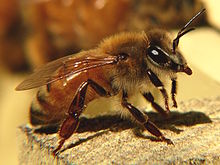Apis mellifera ligustica
| Italian bee Apis mellifera ligustica |
|
|---|---|
 |
|
| Scientific classification | |
| Kingdom: | Animalia |
| Phylum: | Arthropoda |
| Class: | Insecta |
| Order: | Hymenoptera |
| Family: | Apidae |
| Genus: | Apis |
| Species: | A. mellifera |
| Subspecies: | A. m. ligustica |
| Trinomial name | |
|
Apis mellifera ligustica Spinola, 1806 |
|
Apis mellifera ligustica is the Italian bee which is a subspecies of the western honey bee (Apis mellifera).
The Italian honey bee is thought to originate from the continental part of Italy, south of the Alps, and north of Sicily. The subspecies may have survived the last Ice Age in Italy. It is genetically a different subspecies than that from the Iberian peninsula and from Sicily. It is the most widely distributed of all honey bees, and has proven adaptable to most climates from subtropical to cool temperate, but it is less successful in humid tropical regions. It is sometimes called the Ligurian bee.
Italian bees, having been conditioned to the warmer climate of the central Mediterranean, are less able to cope with the "hard" winters and cool, wet springs of more northern latitudes. They do not form such tight winter clusters. More food has to be consumed to compensate for the greater heat loss from the loose cluster. The tendency to raise broods late in autumn also increases food consumption. The noted beekeeper, Thomas White Woodbury, first introduced the Italian bee to Britain in 1859 and regarded it as vastly superior to the English Black.
There is no clear evidence that A. m. ligustica is more resistant to acarine mites than the Northern dark bee. They also appear to be less tolerant of Nosema than Northern dark bees. They are unable to retain faeces in the gut for long periods and require more frequent cleaning flights than the dark bees. They are affected by the parasitic varroa mite, Tracheal Mites, and the bacterial diseases European Foulbrood, American Foul Brood, Chalkbrood and other diseases of the honey bee.
...
Wikipedia
